Snapdragon 835 Benchmarks Revealed: All you need to know about the new chip
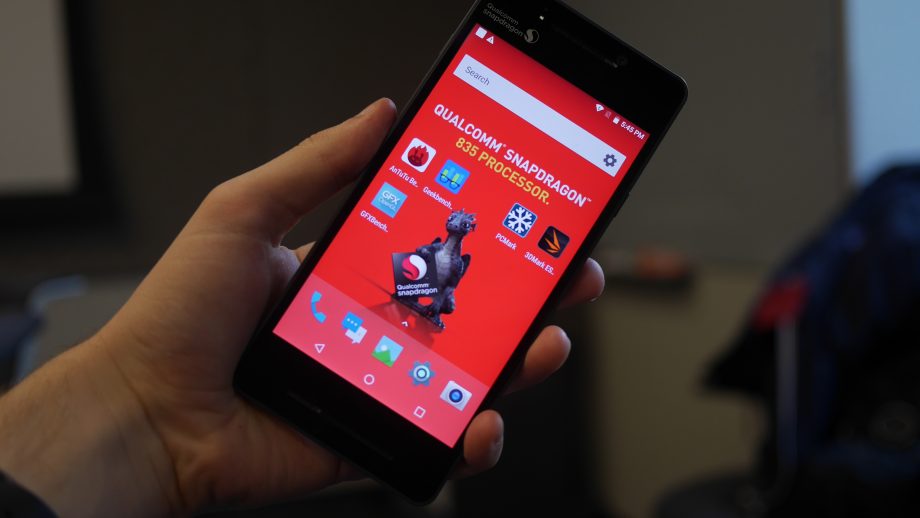
We finally have our own Snapdragon 835 benchmark results for the Qualcomm Snapdragon 835 Mobile Platform and it looks like significant performance improvements have been made across the board. Here’s everything you need to know about the Snapdragon 835, including benchmark results, new features and where you’ll find it this year.
What is the Snapdragon 835?
The 835 is Qualcomm’s mobile system on a chip (SoC), which contains all the key ingredients that sit at the heart of a smartphone. This includes the CPU, graphics processor, Wi-Fi and 4G modems, sound hardware and sensor hubs, among others.
It’s the successor to the Snapdragon 821, which launched last year as a minor improvement to the 820. Found in many of last year’s top-end phones, including the Samsung Galaxy S7, OnePlus 3T and HTC 10, this was the pinnacle of Android smartphone chipsets in 2016.
But now there’s a new king. On paper, the Snapdragon 835 offers significant differences over the 821. Physically, it’s much smaller, which is a result of the push into a 10nm (nanometre) production process from the 821’s 14nm process.
Related: Best smartphones
This sounds complicated, but in simple terms the reduction in process size means the chip’s transistors – the yes/no gates that do all the work – can be packed much closer together. This can lead to more efficient running, which in turn results in lower power consumption, less heat and better performance across the board.
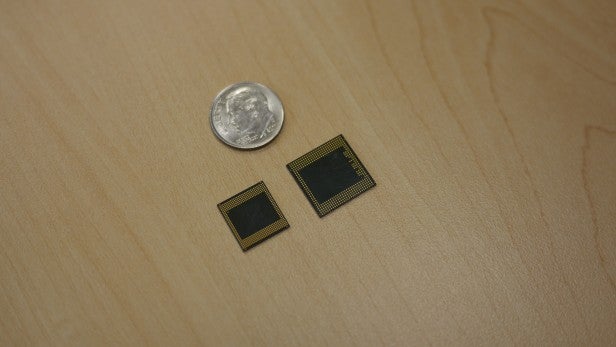 Left: Qualcomm Snapdragon 835, Right: Snapdragon 821
Left: Qualcomm Snapdragon 835, Right: Snapdragon 821
The reduction in the size of the chip also means greater flexibility for smartphone manufacturers to add slightly larger batteries or make slightly thinner phones, for example.
Snapdragon 835 phones
There’s only one phone we officially know will carry the Snapdragon 835, but we’ll make some educated guesses for the rest of the pack:
- Sony Xperia XZ Premium
- HTC 11 (unannounced)
- Galaxy S8 (unannounced)
- OnePlus 4/5 (unannounced)
- Pixel 2 (unannounced)
- LG V30 (unannounced)
Snapdragon 835 – The features you care about
Battery Life: Qualcomm says that, on average, the 835 will use around 25% less power, which will lead to a direct increase to battery life. Of course, this relies on phone makers actually using decent-capacity cells in their handsets instead of choosing slimmer designs with lower capacities.
In some tasks, such as recording high-resolution video and rendering 3D games, the 835 is up to 30% more efficient.
QuickCharge 4: This one’s a biggie. If you thought QuickCharge 3 was speedy, QuickCharge 4 is… well… quicker. Up to 25% faster while managing 30% better efficiency; so that extra speed won’t result in added heat. This is good news for those of us who charge their phones in the vicinity of pillows, with complete disregard for battery safety.
Better Performance: The Snapdragon 835 uses an updated version of Qualcomm’s Kryo CPU, known as the 280. The CPU has eight cores and is based on ARM’s “big.LITTLE” design. Factory fresh, the four “big” cores run at 2.45GHz for snappy performance, while the four “little” cores run at 1.9GHz for those background tasks that don’t require huge power.
Smartphone manufacturers have the final say when it comes to how the cores are actually utilised, which is why you’ll see a range of benchmark scores from each phone that uses the Kryo 280 CPU.
The Adreno 540 is said to be 25% more powerful than its predecessor in 3D performance, so your games will run faster. It also supports 4K UHD Premium and HDR10 video (read more in our guide to HDR) and 10-bit colour displays (that’s 1.07bn colours versus 16.8 million on 8-bit screens).
Scroll down to our benchmarks section for an in-depth look at performance.
Faster Wireless: The Snapdragon 835 features a modem that supports “X16 LTE” speeds, which equates to an absolute maximum 1-gigabit 4G connection. You’ll rarely find that sort of speed anywhere in the world, but that improved modem will also help with more reliable and efficient connections on slower 4G networks.
Optional 802.11ad Wi-Fi is present, too, which is a new, ultra-fast (4.6-gigabit) standard for ultra-short-range data transfers. It hasn’t really found widespread support anywhere yet, but there are potential uses for transferring huge media files to your phone without having to plug it into your PC.
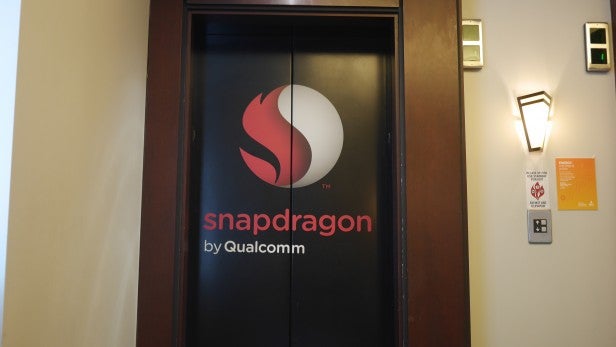 Snapdragon 835 will offer… elevated performance
Snapdragon 835 will offer… elevated performance
Related: Best budget phones
Finally, the 835 supports Bluetooth 5 – the faster, more reliable and longer-range wireless standard. There aren’t any consumer products available to connect to just yet, but rest assured that when they do appear, you’ll be happy you have Bluetooth 5 on board.
Camera: The 835 now supports Qualcomm’s EIS (electronic image stablisation) 3.0 tech, for shake-free video. It uses a new algorithm that better understands how the phone is moving and corrects the image quickly. This feature was previously exclusive to the LG V20, but with the Snapdragon 835, any smartphone maker can take advantage of it.
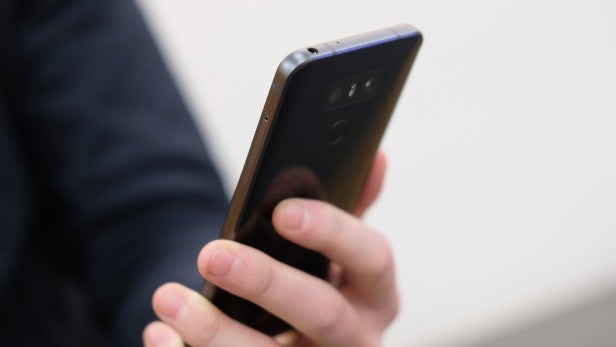 The 821-powered LG G6 was the first smartphone to feature Qualcomm’s latest camera tech, a feature that’s been carried over to the 835
The 821-powered LG G6 was the first smartphone to feature Qualcomm’s latest camera tech, a feature that’s been carried over to the 835
Similarly, the 835 now has built-in dual-camera support. This allows it to handle two 16-megapixel sensors at the concurrently, meaning you can zoom in seamlessly as you can on the LG G6, which had the same technology built into its 821 chip. Hopefully, this will make quality dual-camera smartphones more common.
Security: Qualcomm has combined its various security bits and bobs into a single brand, called Qualcomm Haven. This bolsters security in various ways, including keeping track of suspicious app behaviour (even if you ignore all the permissions warnings your phone throws at you) and locking them down before they do any harm. This relies upon smartphone makers and app developers working with Haven, so having an 835 phone doesn’t guarantee you better security.
Haven also includes Qualcomm’s iris-recognition algorithms that were previously exclusive to the Samsung Galaxy Note 7. Again, an 835-powered phone will require an infra-red camera to take advantage, but the internal hardware and software is all sorted at least.
We should note here that we weren’t blown away by the iris scanner in the Galaxy Note 7, although that was more a result of its reliance on you lifting the phone to eye level in order to have to unlock it. It is, however, much more secure than a fingerprint scanner – although any phone that adopts the iris-scanning tech is likely to use a fingerprint scanner as well. More choice is better, right?
Audio: The 835 now supports 32-bit, 384KHz audio DACs (digital-to-analogue converters), if your smartphone maker of choice decides to include one. We were huge fans of the high-end DAC in the 820-powered HTC 10, so let’s hope whatever phone HTC makes with the 835 takes advantage of this even-better audio quality.
Qualcomm Snapdragon 835 – Benchmark results versus 821, Apple A10, Exynos 8890 and Kirin 960
Now for the bit you were waiting for. Qualcomm has given us early access to non-production smartphones running the 835 to see how it performs in our key benchmarks. To make things fair and interesting, we’ve also re-run the same benchmarks – updated to the latest versions – on last year’s key smartphone CPUs.

The contenders
- Prototype Snapdragon 835 (6GB of RAM)
- Google Pixel XL (Qualcomm Snapdragon 821, 4GB of RAM)
- Galaxy S7 Edge (Samsung Exynos 8890, 4GB of RAM)
- Huawei P10 Plus (HiSilicon Kirin 960, 6GB of RAM)
- iPhone 7 Plus (Apple A10 Fusion, 3GB of RAM)
First, the AnTuTu benchmark. This test runs through lots of different tests including 3D work and processor-intensive tasks, and spits out an overall score. It’s a heavy-handed way of measuring a phone’s overall performance, as a high or low score in one area can upset the overall result.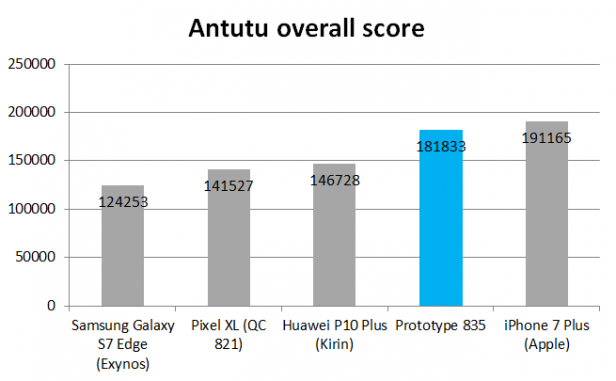
In the pecking order, the 835 acquitted itself as the fastest Android by quite some margin, more than 35,000 points ahead of the Kirin-powered Huawei P10 Plus. It was slower than the iPhone 7 Plus, although comparing benchmarks on different operating systems is rather hazardous since the two work completely differently.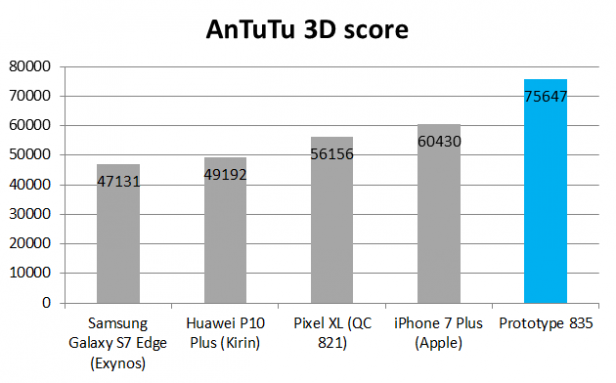
Probably the most interesting score on the AnTuTu benchmark is the 3D graphics score. This demonstrates how well the chip will perform in high-end gaming tasks. The 835’s Adreno GPU put in a pretty amazing score of 75,647, eclipsing the Snapdragon 821, Exynos 8890 and Kirin 960. Even the iPhone 7 Plus, long considered the best phone for gaming, was put into the shade.
Of course, are there any games that will take advantage of this blazing speed? Probably not right now, so the benefits are a bit moot, to be frank. But, as is always the case with gaming, investing in the future is never a bad thing.
Finally, we look at Geekbench 4. This test covers single-core performance (good for knowing how fast a phone will feel in everyday tasks) and multi-core performance (video and photo editing).
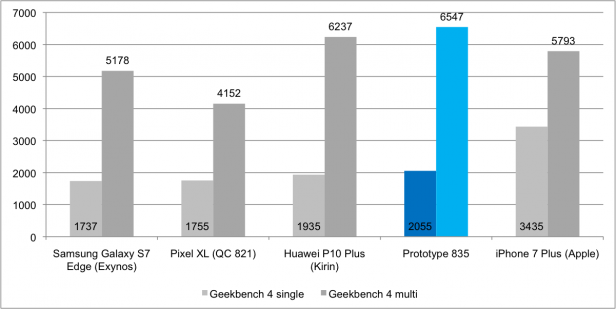
Single-core is much more important for most tasks, and the 835 does a decent job here, just eeking out the Kirin 960. However, it’s still well behind the king of single-core computing, the Apple A10 Fusion. There are lots of reasons for this beyond the capabilities of the CPU. Apple uses high-end components that most other Android phones don’t, including incredibly fast memory that directly helps single-core performance. Plus, iOS is more tightly integrated with the iPhone’s hardware. That’s why iPhones always feel so snappy.
The 835 did well in the multi-core tests, a little ahead of the Kirin 960 and a decent chunk ahead of the A10 Fusion.
Performance conclusions
The 835 is clearly a handy performer, but it faces stiff competition from HiSilicon’s Kirin 960 and, as ever, Apple’s A10 Fusion. Not surprisingly, it obliterates previous-gen kit from Samsung, but we’ve yet to see what sort of performance the new Samsung Exynos 8895 will be capable of.
Given the Exynos is built on the same 10nm process and is based on ARM designs, we’d expect the two processors to perform similarly.
There are plenty of unknowns right now. The lower power consumption figures and faster charging are as-yet untested by us, and beyond raw performance, will be key when it comes to making a buying decision.
Related: Samsung Galaxy S8
What do you think of our benchmarks? Let us know in the comments.


